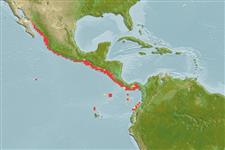Common names from other countries
Environment: milieu / climate zone / depth range / distribution range
Ekologi
laut dasar (demersal); nir-ruaya; kisaran kedalaman 80 - 523 m (Ref. 58018). Subtropical; 28°N - 1°N, 113°W - 78°W (Ref. 58452)
Eastern Pacific: off the west coast of the Americas from Del Mar, California to Ensenada de Tumaco, Colombia. Vrooman and Paloma's (1970) dwarf hake off the coast of Baja California has recently been described as a different species, Merluccius hernandezi Mathews, 1985.
Length at first maturity / Size / Weight / umur
Maturity: Lm 22.0, range 18 - 27 cm
Max length : 40.0 cm TL jantan/; (Ref. 1371); common length : 32.0 cm TL jantan/; (Ref. 1371)
Duri punggung (Keseluruhan (total)) : 1; duri punggung lunak (Keseluruhan (total)) : 45 - 52. Head rather long, about 30% of SL. Gill rakers long and slender, with pointed tips. Pectoral fins long, the tips reaching to or beyond the origin of the anal fin. Overall color silvery, lighter ventrally.
Occurs from shallow continental shelf to the upper continental slope, and in the mid-waters of the open sea and on sea-mounts (Uncle Sam Bank). Exploited only on a local level due to its abundance and its relatively small median size (Ref. 9119). Minimum length of first sexual maturity for both sexes is 18-19 cm, and spawning occurs from April to June, or later (Ref. 58452).
Life cycle and mating behavior
Maturities | Reproduksi, perkembang biakan | Spawnings | Egg(s) | Fecundities | Larva
Cohen, D.M., T. Inada, T. Iwamoto and N. Scialabba, 1990. FAO species catalogue. Vol. 10. Gadiform fishes of the world (Order Gadiformes). An annotated and illustrated catalogue of cods, hakes, grenadiers and other gadiform fishes known to date. FAO Fish. Synop. 125(10). Rome: FAO. 442 p. (Ref. 1371)
Status IUCN Red List (Ref. 130435)
CITES (Ref. 128078)
Not Evaluated
ancaman kepada manusia
Harmless
penggunaan manusia
Perikanan: nilai komersial kecil
Alat, peralatan
laporan khas
muat turun XML
Sumber internet
Estimates based on models
Preferred temperature (Ref.
115969): 11.1 - 13.7, mean 12.6 (based on 24 cells).
Phylogenetic diversity index (Ref.
82804): PD
50 = 0.5000 [Uniqueness, from 0.5 = low to 2.0 = high].
Bayesian length-weight: a=0.00447 (0.00243 - 0.00821), b=3.09 (2.93 - 3.25), in cm Total Length, based on LWR estimates for this Genus-body shape (Ref.
93245).
Trophic level (Ref.
69278): 4.0 ±0.5 se; based on size and trophs of closest relatives
Daya lenting (Ref.
120179): sedang, Waktu penggandaan populasi minimum 1.4 - 4.4 tahun (K=0.34-0.35; tm=3; tmax=7).
Fishing Vulnerability (Ref.
59153): Low to moderate vulnerability (33 of 100).
Climate Vulnerability (Ref.
125649): Moderate vulnerability (39 of 100).
